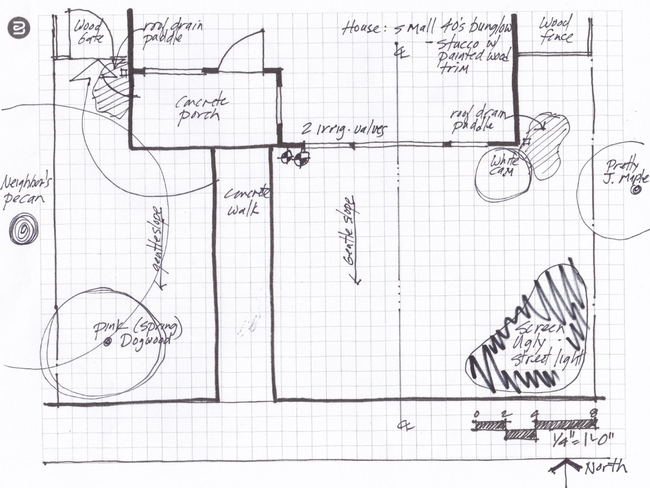Are you ready to convert your thirsty lawn to a beautiful array of low water plants? Have you had your fill of the “crazy quilt” approach to planting? Do you wonder why some gardens seem perfect in their space? Would you like to create a garden that makes a personal statement?
Eve Werner's Planting Design Basics can help. This and three subsequent Real Dirt articles will summarize the PowerPoint Presentation she created for the Butte County Master Gardeners Spring 2017 Workshop Series.

What are these four basic questions? 1: What can I give my plants; 2: What garden style do I want; 3: What plant ‘jobs' need to be filled in my yard; and, 4: Is my yard ready to plant. This article focuses on question one. Questions two through four will be covered in coming weeks.
What can I give my plants: A great design starts with understanding what you already have. Matching plants to your site conditions is an easy way to create a beautiful garden with happy plants, and reduced maintenance and water use. Perform a simple site analysis to gain a solid understanding of what you offer plants.
Begin by drawing a base map, to scale, of the site. Include the house footprint, the location of doors and windows, existing plants that you want to keep, hard scape areas such as paving and fencing, and utilities. Note the architectural style of your home. Make several copies of your base map.
Observe and record onto your base map information that you want to consider when designing your garden. First, note your yard's relationship to your home. This could include potential locations of features that you want to screen or highlight when viewed from within your house. Next, note slope and drainage issues, including areas that puddle easily or slopes that cause water run-off. Finally, consider the relationship to neighboring properties; record features such as large trees or buildings that cast shade on your yard, unattractive items that need to be screened or beautiful elements that you want to ‘borrow' for your scenery.
Next, determine cultural conditions - solar exposure, soil texture, water, and maintenance – that will affect plant growth. Knowing your cultural conditions will lead you to select appropriate plant species.

Soil texture refers to the proportions of different sizes of mineral (sand, silt, and clay) and organic particles in soil. Sandy soils have a large percentage of coarser particles. These soils drain fast, lose nutrients quickly, and are easily eroded. On the other end of the soil texture spectrum, clay soils have finer particles, hold water, retain nutrients, and are easily compacted. Most soils are composed of a mix of sand, soil, and clay soils with varying amounts of organic matter. Look up online how to use the soil texture “ribbon test” to quickly estimate your soil type.
For water analysis, know your average annual rainfall, and decide how much fake rain you are willing to provide through supplemental irrigation. Choose your irrigation methods (drip, spray, soaker hose), and check if you need to replace or update any existing irrigation systems.
Maintenance means the weeding, deadheading, pruning, raking, etc. required to keep a garden looking good. All gardens require some level of maintenance but plant choice and design style greatly affect the level of maintenance. Who will be maintaining your garden? What is their level of experience? How much time will be spent maintaining your garden? Your planting design should reflect your maintenance abilities. Formal gardens with many plants that are poorly adapted will require skilled care and much more maintenance than naturalistic gardens with plants that have evolved to thrive under your cultural conditions.
Once you have created a base map and performed a site analysis you will know the growing conditions that you can offer your plants. Now, you are ready to consider the remaining three questions that will be covered in upcoming Real Dirt articles. Happy Gardening!
UC Master Gardeners of Butte County are part of the University of California Cooperative Extension (UCCE) system. To learn more about us and our upcoming events, and for help with gardening in our area, visit our website. If you have a gardening question or problem, email the Hotline at mgbutte@ucanr.edu (preferred) or call (530) 538-7201.